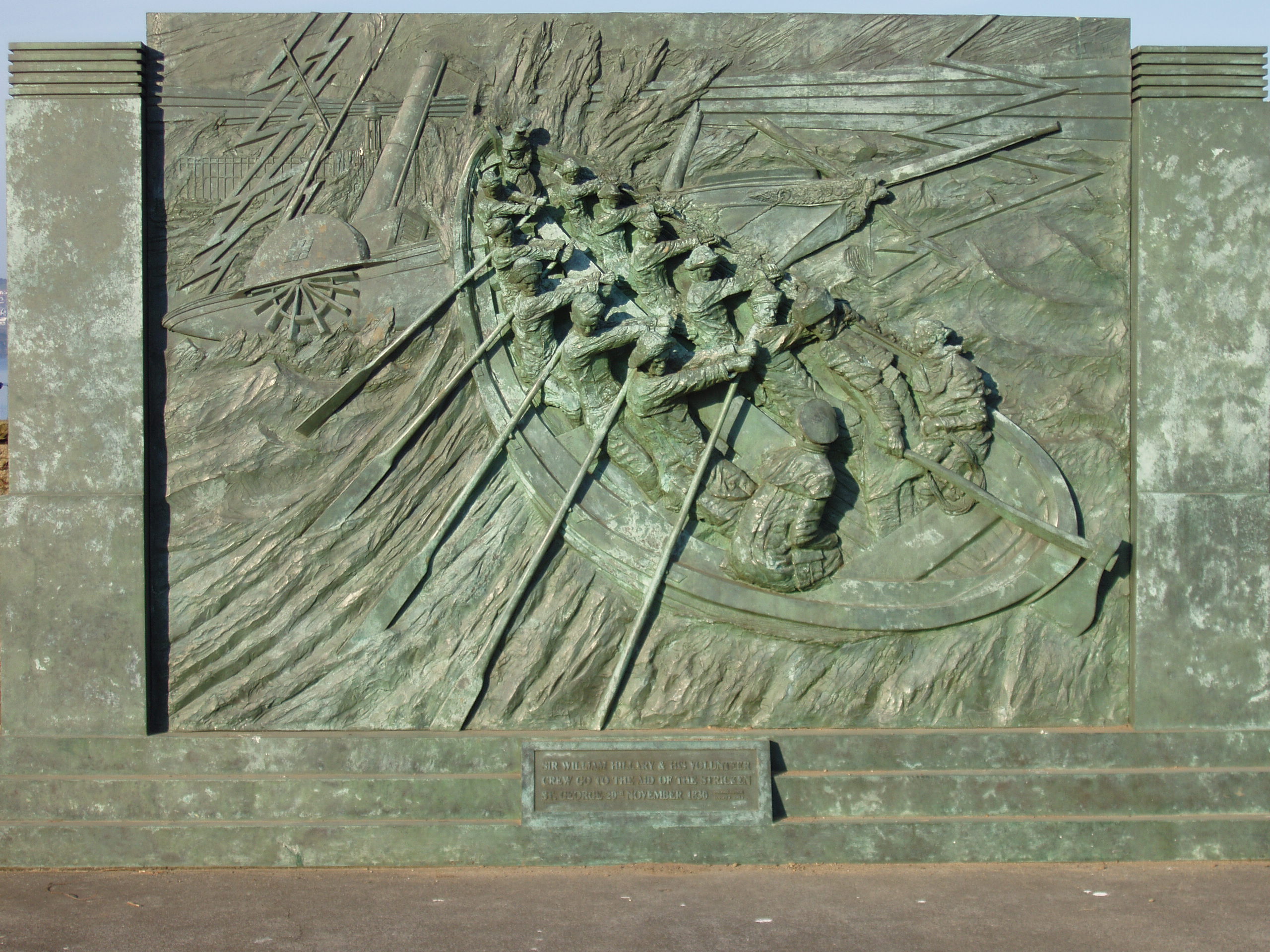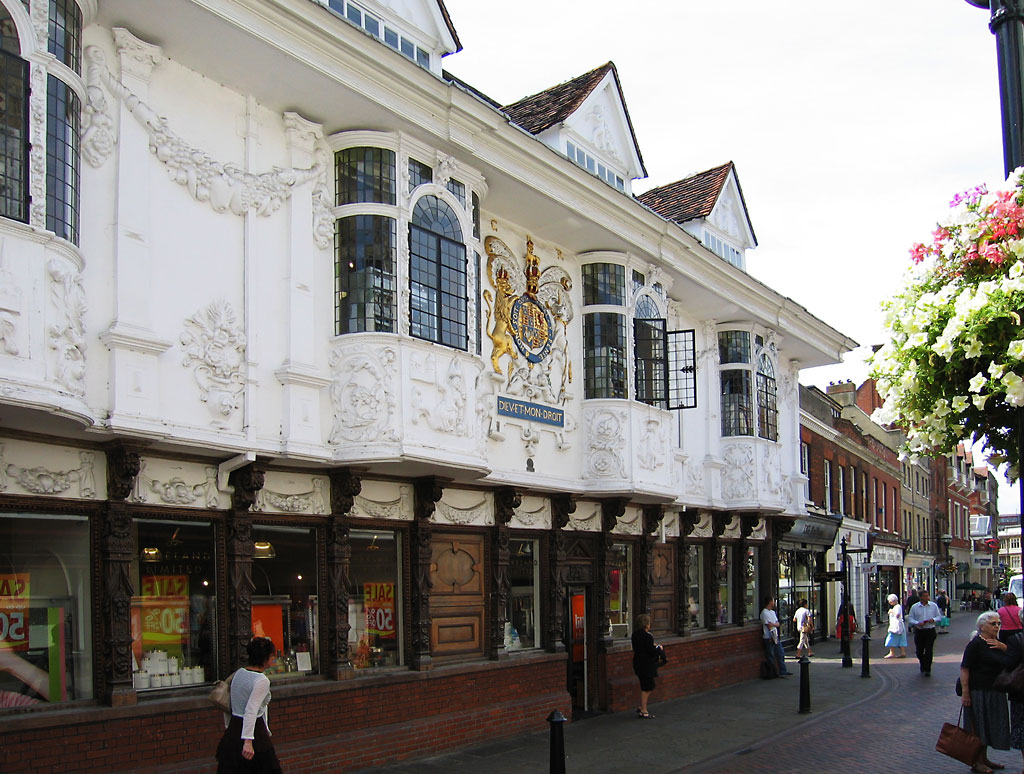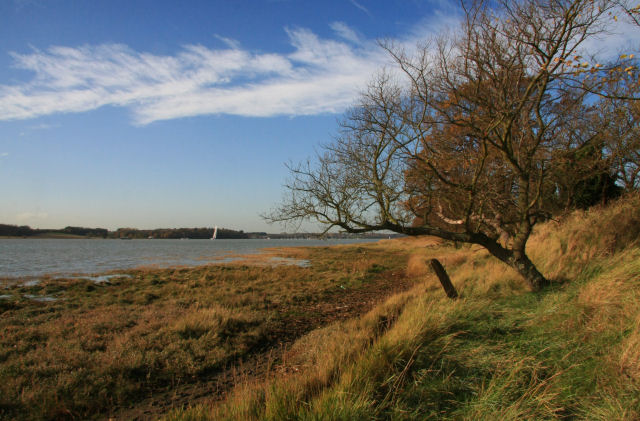|
Landguard Fort Lifeboat
The Landguard Fort Lifeboat is an example of early attempts to design an unsinkable vessel. Several years before the foundation of the RNLI, Richard Hall Gower had been addressing the special problems of lifeboat design. Bayleys at Ipswich built one to his design, being paid for by public subscription initiated by Admiral Page. They launched her from the yard near Stoke Bridge in April 1821 and thoroughly tested her on the Orwell. She took station at Landguard Fort, South of Felixstowe. There is a plan of this vessel in Gower's "Original Observations". She had a long flat floor, flared out to project at both head and stern. She was steered by a long sweep over the stern. Fourteen copper-clad water-tight cases, five on each side and four down the mid line provided buoyancy. Oars and two foul-weather sprit-sails provided propulsion and there was provision for self-draining when she was fully waterlogged. About 30' overall and 7' breadth, she was capable of supporting 25 men even w ... [...More Info...] [...Related Items...] OR: [Wikipedia] [Google] [Baidu] |
RNLI
The Royal National Lifeboat Institution (RNLI) is the largest of the lifeboat services operating around the coasts of the United Kingdom, Ireland, the Channel Islands, and the Isle of Man, as well as on some inland waterways. Founded in 1824 as the National Institution for the Preservation of Life from Shipwreck, it soon afterwards became the Royal National Institution for the Preservation of Life from Shipwreck because of the patronage of King George IV. Royal patronage has continued up to the present day with King Charles III. The organisation changed its name to the Royal National Lifeboat Institution on 5 October 1854 and was granted a royal charter in 1860. The RNLI is a charity based in Poole, Dorset. It is principally funded by legacies (65%) and donations (30%). Most of its lifeboat crews are unpaid volunteers. They operate more than 400 lifeboats from 238 stations. Paid lifeguards provide services at nearly 250 beaches. The RNLI also provides free safety advice to ... [...More Info...] [...Related Items...] OR: [Wikipedia] [Google] [Baidu] |
Richard Hall Gower
Richard Hall Gower (1768 – July 1833) was an English sea captain, philosopher, inventor and entrepreneur. Mariner Richard was the youngest son of Rev. Foote Gower, physician and antiquarian, and Elizabeth, a sister of John Strutt (1727–1816), John Strutt, Member of Parliament for Maldon (UK Parliament constituency), Maldon. He won a scholarship to Winchester College. He left school, "thankfully", to join the British East India Company as a midshipman in the vessel Essex (1780 EIC ship), ''Essex'' carrying troops and invalids. He was a lively and observant lad. At the age of 16 he was promoted captain of the Top (sailing ship), main top, where he waged active war with the lads of the Top (sailing ship), fore top, Shroud (sailing), shrouds and Stays (nautical), stays providing the high roads of communication. He was noted for his spirit and ingenuity, his depth of knowledge of his ship and his skill as a ship model maker; unravelling stockings to obtain rigging materials. Whe ... [...More Info...] [...Related Items...] OR: [Wikipedia] [Google] [Baidu] |
Lifeboat (rescue)
A rescue lifeboat is a boat rescue craft which is used to attend a vessel in distress, or its survivors, to rescue crew and passengers. It can be hand pulled, sail powered or powered by an engine. Lifeboats may be rigid, Inflatable boat, inflatable or rigid-inflatable combination-hulled vessels. Overview There are generally three types of boat, in-land (used on lakes and rivers), in-shore (used closer to shore) and off-shore (into deeper waters and further out to sea). A rescue lifeboat is a boat designed with specialised features for searching for, rescuing and saving the lives of people in peril at sea or other large bodies of water. In the United Kingdom and Ireland rescue lifeboats are typically vessels crewed by volunteers, intended for quick dispatch, launch and transit to reach a ship or individuals in trouble at sea. Off-shore boats are referred to as 'All-weather' and generally have a range of 150–250 nautical miles. Characteristics such as capability to withstand he ... [...More Info...] [...Related Items...] OR: [Wikipedia] [Google] [Baidu] |
Ipswich
Ipswich () is a port town and Borough status in the United Kingdom, borough in Suffolk, England. It is the county town, and largest in Suffolk, followed by Lowestoft and Bury St Edmunds, and the third-largest population centre in East Anglia, after Peterborough and Norwich. It is northeast of London and in 2011 had a population of 144,957. The Ipswich built-up area is the fourth-largest in the East of England and the 42nd-largest in England and Wales. It includes the towns and villages of Kesgrave, Woodbridge, Suffolk, Woodbridge, Bramford and Martlesham Heath. Ipswich was first recorded during the medieval period as ''Gippeswic'', the town has also been recorded as ''Gyppewicus'' and ''Yppswyche''. It has been continuously inhabited since the Anglo-Saxon settlement of Britain, Saxon period, and is believed to be one of the Oldest town in Britain, oldest towns in the United Kingdom.Hills, Catherine"England's Oldest Town" Retrieved 2 August 2015. The settlement was of great eco ... [...More Info...] [...Related Items...] OR: [Wikipedia] [Google] [Baidu] |
Admiral Page
Admiral is one of the highest ranks in many navies. In the Commonwealth nations and the United States, a "full" admiral is equivalent to a "full" general in the army or the air force. Admiral is ranked above vice admiral and below admiral of the fleet, or fleet admiral. Etymology The word in Middle English comes from Anglo-French , "commander", from Medieval Latin , . These evolved from the Arabic () – () (), "king, prince, chief, leader, nobleman, lord, a governor, commander, or person who rules over a number of people" and (), the Arabic definite article meaning "the." In Arabic, admiral is also represented as (), where al-Baḥr (البحر) means the sea. The 1818 edition of Samuel Johnson's ''A Dictionary of the English Language'', edited and revised by the Rev. Henry John Todd, states that the term "has been traced to the Arab. emir or amir, lord or commander, and the Gr. , the sea, q. d. ''prince of the sea''. The word is written both with and without the d, in ... [...More Info...] [...Related Items...] OR: [Wikipedia] [Google] [Baidu] |
River Orwell
The River Orwell flows through the county of Suffolk in England from Ipswich to Felixstowe. Above Ipswich, the river is known as the River Gipping, but its name changes to the Orwell at Stoke Bridge, about half a mile below where the river becomes tidal by Bobby Robson Bridge on West End Road. It broadens into an estuary at Ipswich, where the Ipswich dock has operated since the 7th century, and then flows into the North Sea at Felixstowe, the UK's largest container port, after joining the River Stour at Shotley forming Harwich harbour. The large Orwell Bridge carries the A14 trunk road over the estuary to the south of Ipswich. Name In the name ''Orwell'', ''Or-'' comes from an ancient river-name—probably pre-Celtic; but ''-well'' probably indicates an Anglo-Saxon naming. In ''A tour through England and Wales'', written in 1722, Daniel Defoe calls the river "Orwel" (though he does this inconsistently). He also mentions that "a traveller will hardly understand me, especia ... [...More Info...] [...Related Items...] OR: [Wikipedia] [Google] [Baidu] |
Felixstowe
Felixstowe ( ) is a port town and civil parish in the East Suffolk District, East Suffolk district, in the county of Suffolk, England. The estimated population in 2017 was 24,521. The Port of Felixstowe is the largest Containerization, container port in the United Kingdom. Felixstowe is approximately northeast of London. History There are competing theories as to how the name of Felixstowe arose. One is that the town is named after Felix of Burgundy, a saint and the first bishop of the East Angles in the seventh century, although this is unlikely as the name Felixstowe is not recorded for almost 900 years. An alternative etymology is from the Anglo-Saxon or Old English name "Filicia" and "stōw", meaning a place of location. Literally Filicia's place. The earliest recorded names "Filchestou" from 1254, and "Filchestowe" in 1291 support this idea. It is possible that the later reworking of Filicia/Filche was made with the intention of referencing Felix of Burgundy. The old Feli ... [...More Info...] [...Related Items...] OR: [Wikipedia] [Google] [Baidu] |
Oars
An oar is an implement used for water-borne propulsion. Oars have a flat blade at one end. Rowers grasp the oar at the other end. The difference between oars and paddles is that oars are used exclusively for rowing. In rowing the oar is connected to the vessel by means of a pivot point for the oar, either an oarlock, or a thole. The oar is placed in the pivot point with a short portion inside the vessel, and a much larger portion outside. The rower pulls on the short end of the oar, while the long end is in the water. By contrast, paddles are held in both hands by the paddler, and are not attached to the vessel. Rowers generally face the stern of the vessel, reach towards the stern, and insert the blade of their oar in the water. As they lean back, towards the vessel's bow, the blade of their oars pivots in the oarlock, and the end in the water moves towards the stern, providing forward thrust. For thousands of years vessels were powered either by sails, or by the mechanical ... [...More Info...] [...Related Items...] OR: [Wikipedia] [Google] [Baidu] |
Sprit-sails
The spritsail is a four-sided, fore-and-aft sail that is supported at its highest points by the mast and a diagonally running spar known as the sprit. The foot of the sail can be stretched by a boom or held loose-footed just by its sheets. A spritsail has four corners: the throat, peak, clew, and tack. The Spritsail can also be used to describe a rig that uses a spritsail. Historically, spritsails were the first European fore-and-aft rigs, appearing in Greco-Roman navigation in the 2nd century BC. The rig The luff of the sail is bound to the mast, but unlike the gaff rig where the head is bound to a spar, this rig supports the leech of the sail by means of a diagonal spar or spars named a sprit ( ). The forward end of the sprit spar is attached to the mast, with the after end of the sprit spar attached to the peak. The sprit is steadied and controlled from the deck by a pair of wire vangs ( ) attached to the peak of the sail. It is said to be the ancestor of the common gaf ... [...More Info...] [...Related Items...] OR: [Wikipedia] [Google] [Baidu] |
Coxswain
The coxswain ( or ) is the person in charge of a boat, particularly its navigation and steering. The etymology of the word gives a literal meaning of "boat servant" since it comes from ''cock'', referring to the wiktionary:cockboat, cockboat, a type of ship's boat, and ''swain'', an Old English term derived from the Old Norse ''sveinn'' meaning boy or servant. In 1724, a "cockswain" was defined as "An officer of a ship who takes care of the cockboat, barge or shallop, with all its furniture, and is in readiness with his crew to man the boat on all occasions." When the term "cockboat" became obsolete, the title of coxswain as the person in charge of a ship's boat remained. Rowing In rowing, the coxswain sits in either the bow or the stern of the boat (depending on the type of boat) while verbally and physically controlling the boat's steering, speed, timing and fluidity. The primary duty of a coxswain is to ensure the safety of those in the boat. In a race setting, the coxswai ... [...More Info...] [...Related Items...] OR: [Wikipedia] [Google] [Baidu] |
Lifeboats
Lifeboat may refer to: Rescue vessels * Lifeboat (shipboard), a small craft aboard a ship to allow for emergency escape * Lifeboat (rescue), a boat designed for sea rescues * Airborne lifeboat, an air-dropped boat used to save downed airmen Art and entertainment * ''Lifeboat'' (1944 film), a movie directed by Alfred Hitchcock * ''Lifeboat'' (2018 film), a documentary * "Lifeboat" (''Stargate SG-1''), a 2003 television episode * "Lifeboats" (''Succession''), a 2018 television episode * Lifeboat sketch, a sketch shown on ''Monty Python's Flying Circus'' * ''Lifeboat'' (album), a 2008 album by Jimmy Herring * ''Lifeboat'', a 1972 album by the Sutherland Brothers * "Lifeboats", a song on Snow Patrol's 2008 album, ''A Hundred Million Suns'' * "Lifeboat", a song from '' Heathers: The Musical'' Other uses * ''Lifeboat'', journal of the Royal National Lifeboat Institution * Lifeboat ethics, proposed by Garret Hardin based on the metaphor of a lifeboat * Lifeboat Associates ... [...More Info...] [...Related Items...] OR: [Wikipedia] [Google] [Baidu] |





